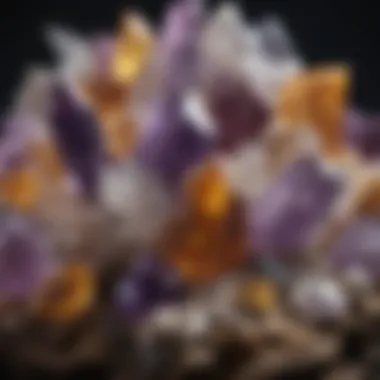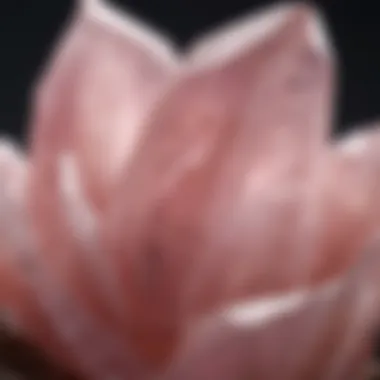Exploring Popular Crystals: A Comprehensive Guide


Intro
Crystals have captivated humans for centuries, both for their aesthetic appeal and their perceived mystical properties. In modern contexts, they are often associated with healing, wellness, and spiritual practices. This guide offers an extensive exploration of popular crystals, aiming to improve understanding among collectors, enthusiasts, and educators alike. Each crystal not only has its unique attributes but also a rich history that ties it to various cultures and uses.
Understanding crystals requires a journey through their history and origins, along with their identification and classification. This foundational knowledge can enrich the experience of handling and discussing these beautiful natural formations.
History and Origins
Crystals have been part of human civilization for a long time. The earliest records of crystal usage date back to ancient civilizations, where they were often used in rituals, for healing, and sometimes as decorative items in burial sites. Each type of crystal carries with it legends and lore that narrate the beliefs and values of the people who cherished them.
Overview of Collectibles, Rocks, and Fossils
Collecting crystals is akin to a treasure hunt. Every stone tells a story, whether it is about its formation deep within the Earth's layers or the geological processes that shaped it. Rocks and fossils serve as valuable data points in understanding the Earth's history, revealing changes in the environment over millions of years.
Historical Significance and Cultural Impact
The cultural significance of crystals goes beyond their physical presence. For instance, the ancient Egyptians valued lapis lazuli for its deep blue color, associating it with the night sky and spirituality. The Chinese have long regarded jade as a symbol of purity and moral integrity. Similarly, Indigenous cultures often attribute healing properties to specific crystals, using them in traditional medicine practices. Understanding these histories can provide greater appreciation for each crystal beyond their visual aspects.
Identification and Classification
Identifying and classifying crystals is vital for collectors and enthusiasts. Knowledge about distinguishing features, such as color, clarity, and structure, can enhance one's ability to appreciate and understand the materials they are working with.
Guide to Identifying Rocks and Fossils
When examining crystals, consider the following points for identification:
- Color: The hue can hint at the mineral composition.
- Hardness: This can be tested using the Mohs scale.
- Luster: Observing how light reflects off the crystal.
- Formation: Noting the structure, whether it be points, clusters, or tumbled stones.
Common Types and Variations
There is a vast array of crystals available, each boasting unique properties:
- Amethyst: Known for its calming abilities and deep purple color.
- Quartz: A versatile and common mineral found in many variations, including rose quartz and smoky quartz.
- Citrine: Renowned for its cheerful yellow hue, often associated with prosperity and abundance.
- Turquoise: This stone is praised not only for its stunning blue-green color but also for its protective qualities.
In summary, the study of crystals opens a door to understanding geological processes, historical significance, and cultural practices. As we delve deeper into their specific characteristics and uses, this guide aims to illuminate the various aspects that make crystals both fascinating and valuable.
Prologue to Crystals
Crystals are not merely objects of beauty; they hold significant value in various contexts, from scientific inquiry to personal well-being. This section serves as an entry point into understanding the multifaceted world of crystals. The knowledge about their characteristics, origins, and applications can deepen appreciation for these natural formations.
Crystals have a rich narrative intertwined with human history, art, and science. The desire to explore crystals often stems from curiosity about their formations and properties. By learning about them, one can foster a deeper connection to nature and gain insights into their unique vibrations.
Furthermore, the exploration of crystals offers tangible benefits. Enhancing well-being, improving focus, and pursuing personal growth are just a few potential outcomes of integrating crystals into one’s life. Understanding their formation and properties can guide enthusiasts to make informed choices in selecting the right crystals for their needs.
What Are Crystals?
Crystals are solid materials whose constituent atoms are arranged in an orderly repeating pattern. This regular arrangement leads to distinctive geometric shapes, which vary widely, giving rise to the diverse forms of crystals seen today. The study of crystals encompasses various fields, including geology, mineralogy, and physics.
Crystals can be formed from different substances, including minerals, organic compounds, and even gases. Common examples include quartz, feldspar, and calcite. Each type of crystal possesses unique properties based on its internal structure and composition.
Crystals are utilized not only for their aesthetic appeal but also for their purported energetic and healing properties, making them a subject of fascination for many people.
Formation of Crystals
The formation of crystals occurs through a process known as crystallization. This can take place either from a liquid or a gas and involves the organized arrangement of atoms or molecules. There are several methods by which crystals can form, with two of the most common being:
- Cooling of molten rock: When magma cools slowly underground, it forms large crystals as atoms have time to bond in the crystalline structure.
- Evaporation: In some situations, when a solvent evaporates, the solute left behind can crystallize, forming solid structures. This is often seen in salt crystals.
The environment in which crystals form greatly influences their characteristics. Factors such as temperature, pressure, and the presence of impurities can all affect the size and clarity of the resulting crystals. Understanding these processes is essential for collectors and enthusiasts, as it enhances their ability to appreciate the beauty and complexity of these natural formations.
Historical Significance of Crystals
Crystals hold a significant place in human history, intertwining with cultures worldwide. Their importance goes beyond mere aesthetics. They have been intricately woven into the spiritual, social, and economic fabrics of societies throughout the ages. Understanding the historical context of crystals offers a deeper appreciation of their current relevance and application.
Crystals in Ancient Cultures
Ancient civilizations recognized the potential of crystals as more than decorative items. The Egyptians, for instance, believed that crystals like lapis lazuli and carnelian had protective properties. They used these stones in jewelry, tombs, and amulets. This practice was rooted in the belief that specific crystals could influence fate and provide safety in the afterlife.
In China, the practice of using jade for its restorative properties is well-documented. Not only did jade symbolize purity and moral integrity, but it also played a role in various rituals and health practices. The Chinese also utilized crystals in traditional Chinese medicine, linking certain stones to specific organs and health aspects.
The Greeks and Romans also valued crystals for both their metaphysical qualities and their physical beauty. They associated different stones with various gods and used them in ceremonies. For instance, amethyst was believed to prevent drunkenness, and was often worn while consuming alcohol, reflecting the belief in the stone’s protective nature.
Overall, these historical usages demonstrate the deep-rooted reverence for crystals, as they were seen as carriers of energy and wisdom, playing a pivotal role in ancient belief systems.
Crystals in Modern Society
The significance of crystals has evolved yet maintained its essence in contemporary society. Today, crystals are popular not only for their beauty but also for their purported healing properties. Many practitioners in alternative medicine advocate for the use of crystals in therapies aimed at emotional and physical healing.
The rise of the New Age movement in the late 20th century further solidified the popularity of crystals. They are now often associated with holistic healing practices, meditation, and mindfulness. People use crystals like rose quartz for self-love, or citrine for abundance and prosperity, showcasing a personal connection to these stones, which reflects an ongoing trend toward self-care and spiritual exploration.
Crystals also play a part in the wellness industry, with many products featuring them as essential components in everything from skincare to interior design. Their aesthetic appeal and energetic beliefs combine to create a multi-faceted market around them.


"The enduring allure of crystals reflects both their ancient significance and modern relevance, transcending time and cultures to touch the lives of many."
Comprehensive List of Popular Crystals
The section of popular crystals is crucial because it allows readers to understand the diverse range of crystal types available. Each crystal carries its distinct properties and significance, which can be extremely beneficial for various purposes, such as healing and decoration. Knowing these attributes helps users make informed choices when selecting crystals that resonate with their personal needs or aesthetic preferences. Additionally, it promotes a deeper appreciation for the natural formations and energies these crystals emanate.
Amethyst
Properties
Amethyst is known for its beautiful purple shade, which can range from light lavender to deep violet. This crystal is often associated with calming properties, promoting tranquility and helping to relieve stress. The reason it is beneficial in this article is that its popularity stems from its broad appeal, making it a user-friendly option for newcomers. Its unique feature is the ability to aid in spiritual growth. However, it is important to note that its effectiveness may vary depending on the individual's sensitivity to energy.
Uses
Amethyst is widely used in meditation practices due to its calming effects. Many people incorporate it in various forms; wearing jewelry or keeping it in their living spaces. The versatility in its usage is a compelling aspect, as it serves both aesthetic and functional purposes. However, while it is widely credited with enhancing intuitive abilities, individual experiences may differ, which could limit its perceived effectiveness for some.
Care tips
To maintain the integrity of amethyst crystals, proper care is essential. Regular cleansing is recommended to remove built-up energies, usually done by rinsing under running water or using sage smudging. It is also advisable to store amethyst away from direct sunlight, as prolonged exposure can fade its color. While the process is straightforward, neglecting this might diminish the crystal's efficacy over time.
Rose Quartz
Properties
Rose Quartz is often referred to as the stone of love, known for its soft pink hue. This crystal is frequently sought after for its reputed ability to foster compassion and emotional healing. Its significance in this guide is tied to its widespread appeal among those seeking to enhance their emotional well-being. One unique trait of this crystal is its potential to encourage self-love, though not everyone may resonate with this attribute.
Uses
The uses of rose quartz range from being a centerpiece in home decor to serving as a tool for promoting emotional peace. Many individuals place it in their bedrooms to enhance loving vibrations. While its beautiful appearance is a draw for many, its effectiveness in fostering interpersonal relationships can be subjective. Some might find great benefit, while others may not feel the same impact.
Care tips
Care for rose quartz crystals includes gentle cleaning to avoid scratching their surface. Users often choose to cleanse them in saltwater or moonlight to recharge their energy. It is vital to handle them with care, as they can chip easily. This attentiveness is not only beneficial for maintaining the crystal's appearance but also its energy.
Clear Quartz
Properties
Clear Quartz is known for its versatility and clarity, often seen as the 'master healer.' It is believed to amplify energy and intentions, which is beneficial in various applications. Its unique clarity encourages a deeper intra-personal clarity. The versatility of clear quartz makes it an integral part of any crystal collection, especially for those invested in energy work.
Uses
Clear Quartz is used in healing practices, meditation, and enhancing energy in spaces. Many users believe it helps to manifest intentions effectively. Its multifaceted applications make it an essential tool for practitioners of various spiritual and healing modalities. However, since it requires a strong intent to direct its energy, its effectiveness can vary significantly between users.
Care tips
Proper care for clear quartz includes regular cleansing using water and salt. It is advisable to store it in a protective pouch to prevent scratches. Unlike some other crystals, clear quartz is sturdy, but regular care helps in preserving both its appearance and healing properties.
Citrine
Properties
Citrine is celebrated for its warm yellow to golden hue. It embodies positivity and abundance, often associated with prosperity. The beneficial aspect of citrine is its ability to promote an uplifting environment. However, it is worth mentioning that its effectiveness may rely on personal beliefs about its properties.
Uses
This crystal is widely used in manifestation practices and is often placed in workspaces to attract wealth. Its unique feature is its association with solar energy, making it feel vibrant and active. While popular, the perceived effectiveness of citrine’s abundance-pulling properties can be influenced by the user’s mindset and openness to receiving.
Care tips
To care for citrine, it’s best to cleanse it periodically using a soft cloth. Avoid cleaning it with harsh chemicals. Storage in a dry, cool place helps to maintain its vibrant color. Proper care will ensure it remains both attractive and effective over time.
Tiger's Eye
Properties
Tiger's Eye is distinguished by its striking golden-brown stripes that resemble a cat's eye. This crystal is known for its grounding and protective qualities. A key reason for its inclusion in this guide is its popularity among those seeking balance and focus. Its unique ability to enhance mental clarity sets it apart from other crystals.
Uses
Many people utilize Tiger's Eye to boost courage and confidence, often carrying it during challenging tasks. Its protective qualities make it a favored choice in stressful environments. While many report positive experiences, this crystal's effectiveness may vary among individuals, making personal connection vital.
Care tips
To keep Tiger's Eye in good condition, gentle cleaning with a damp cloth is recommended. Avoid exposure to high temperatures and direct sunlight, which may cause fading. Careful handling can prolong its life, allowing users to benefit from its properties long term.
Obsidian
Properties
Obsidian is a volcanic glass that is often black and shiny, associated with strength and protection. Its significance derives from its ability to absorb negative energy and facilitate transformation. This makes it particularly beneficial for those seeking to confront and release fears. Its unique feature lies in its ability to encourage clarity in facing one’s issues, although it might bring discomfort for some users.


Uses
Obsidian is frequently used in spiritual practices to cut through illusions and provide clarity during challenging times. Due to its grounding nature, many practitioners use it to set boundaries. While the results can be powerful, users should be aware that its intense energy might be overwhelming for some.
Care tips
Cleaning obsidian is simple; rinsing under water is usually sufficient. As it is fragile, proper care includes storing it away from heavy items. Being cautious will help maintain its integrity and effectiveness in energy work.
How to Choose Crystals
Choosing the right crystals is a vital aspect of their effective use, whether for healing, decoration, or collection. Each crystal carries unique properties and energies. This section will help you understand how to select the crystals that are most beneficial for your personal needs and goals. It involves recognizing your intentions, understanding the qualities of different crystals, and discerning their energy vibrations. Educating yourself in this area can enhance your experience and connection with these remarkable stones.
Identifying Personal Needs
Before acquiring a crystal, it is essential to identify what you seek to achieve. Crystals have diverse applications, including physical healing, emotional balance, and spiritual growth. Ask yourself these questions:
- What issues or challenges am I currently facing?
- Am I looking for support in my personal relationships or career?
- Is there a specific energy or quality I am drawn to?
For instance, if you feel anxious, a crystal like Amethyst may be beneficial. If you're looking for love, Rose Quartz is traditionally associated with compassion and healing relationships. Engaging in thoughtful reflection on your needs can guide you towards finding the right crystal to align with your aspirations.
Assessing Energy and Vibrations
Every crystal emits a distinct vibration, which interacts with the human energy field in various ways. To choose effectively, consider the following steps:
- Feel the Crystal: When possible, hold the crystal in your hand. Notice how it feels. Some individuals report sensations such as warmth, calmness, or tingling.
- Listen to Your Intuition: Often, your subconscious will guide you toward a particular crystal. Trusting your instinct can lead you to the one that resonates most with your current state.
- Research Properties: Understand the common properties associated with each crystal. Researching from reputable sources can provide insight into their specific healing aspects.
"The right crystal will not only resonate with your needs but will also empower you in your journey towards well-being."
Familiarity with these elements allows you to curate a collection that genuinely reflects your personal journey and intentions, enhancing your relationship with the natural world through these geological marvels.
Caring for Your Crystals
Caring for your crystals is essential for both their physical preservation and their metaphysical benefits. Many people believe that crystals carry unique energies and vibrations, which can be amplified through proper care and maintenance. A well-cared-for crystal maintains its beauty and efficacy, ensuring it serves its intended purpose for longer periods. This section offers insights into the best practices for cleaning and storing crystals, helping collectors and enthusiasts maintain their collections effectively.
Cleaning Techniques
Cleaning crystals is crucial to remove any buildup of negative energy and physical dirt that may accumulate over time. Several methods can be employed, but it's vital to choose one that aligns with the specific type of crystal, as some may be sensitive to certain cleaning techniques.
- Water Cleaning: For durable crystals like Amethyst or Clear Quartz, rinsing under cool running water can be effective. Gently cleanse the crystal while visualizing the negative energy wash away. Avoid water for softer stones, like Selenite, as it can damage them.
- Salt Cleansing: Salt is believed to absorb negative energy. If you opt for this method, bury your crystals in natural sea salt for a few hours or overnight. Afterward, rinse them under cool water to remove any salt residue.
- Sound Cleansing: Utilizing sound waves can rejuvenate crystals. Tools like singing bowls or tuning forks can create vibrations that cleanse the stones. Simply place the crystal near or in the pathway of the sound for optimal results.
- Smudging: Smudging involves the burning of sacred herbs such as sage or sweetgrass. Pass your crystals through the smoke, allowing the cleansing properties of the herbs to envelop them.
"Regular cleaning opens portals for positive energy, maintaining the crystal’s natural balance."
Each cleaning method has different implications for the type of crystal you are using, so it's beneficial to research the best techniques tailored to individual stones.
Storing Crystals
Proper storage of crystals is necessary to prevent damage and preserve their energies. Crystals should be kept in a safe and secure location away from sunlight, heat, or high humidity, which can alter their properties over time.
- Display Boxes: Consider using glass display boxes to showcase your collection. This keeps the crystals visible while protecting them from dust and handling.
- Cushioned Storage: When storing crystals away from view, consider wrapping them in soft fabric or using a padded container. This prevents chipping or scratching of fragile surfaces.
- Avoiding Bumps: Keep different types of crystals separate. Harder stones can scratch softer ones, so designate individual sections within a box or drawer for each type.
The Science Behind Crystals
The study of crystals encompasses several scientific disciplines. Understanding the science behind crystals allows enthusiasts to appreciate not just their aesthetic appeal, but also their intricate properties and the phenomena that govern them. The structural arrangement of atoms within a crystal influences its mechanical, optical, and electromagnetic characteristics. This is crucial for collectors who wish to understand the value and applications of crystals.
The significance of crystals extends beyond appearances. When individuals explore their physical features, they uncover details about how they formed, their potential applications in technology, and their role in alternative healing practices. This section reviews two critical aspects: Crystal Geometry and Electromagnetic Properties.
Crystal Geometry
Crystal geometry refers to the external expression of the internal atomic arrangement within a crystal. It constitutes an important framework for classifying crystals into different systems, such as cubic, hexagonal, and tetragonal. Each crystal system exhibits unique symmetry and angle relations among its faces. Understanding these geometrical aspects helps collectors identify and categorize crystals accurately.
In addition to classification, geometric structure impacts a crystal's properties. For instance, the symmetrical alignment can affect the crystal's hardness and fracture patterns. Many collectors are captivated by the variety of shapes, ranging from the dialogue of sharp points in quartz to the smooth surfaces of rose quartz. Such geometric qualities can provide insight into how a crystal may be used in healing or decorative functions.
Here are the primary crystal systems:
- Cubic: Equal axes and angles. Examples include diamond and pyrite.
- Hexagonal: Four axes, three in a plane of equal length. Examples include quartz and beryl.
- Tetragonal: Three axes, two equal in length. Examples include rutile and zircon.
Investigating these systems reveals both aesthetic and structural aspects, enhancing the knowledge base of crystal collectors and enthusiasts.
Electromagnetic Properties
Electromagnetic properties are fundamental in understanding how crystals interact with light and electricity. Each crystal can exhibit unique behaviors in response to electromagnetic fields. This includes behaviors such as piezoelectricity, where certain crystals generate an electric charge in response to applied mechanical stress. A popular example includes quartz, widely used in precision instruments due to its piezoelectric abilities.
Additionally, some crystals can selectively absorb, transmit, or reflect light. This selective interaction contributes to their dazzling displays and varied colors, appealing to collectors and jewelers alike. For instance, amethyst absorbs particular wavelengths that results in its characteristic purple hue.
Crystals' electromagnetic properties invite research into practical applications in technology, such as fiber optics and laser technology. Their characteristics pave the way for innovations in industries ranging from telecommunications to renewable energy solutions.
"The intricate dance of atoms within crystals is not only a spectacle for the eye; it is a foundation for modern technology and healing practices."
In summary, recognizing the science behind crystals enhances their allure. Understanding crystal geometry and their electromagnetic properties equips collectors and enthusiasts with essential knowledge, enabling informed decisions and deeper appreciation.
Crystals in Healing Practices


The realm of crystals extends far beyond their physical beauty; many believe they possess unique healing properties. This notion has gained traction within various alternative medicine communities. The intersection of mineralogy and holistic health attracts both practitioners and enthusiasts alike. Understanding the role of crystals in healing practices can illuminate their potential benefits, limitations, and the ideology behind their use in personal wellness.
Alternative Medicine Perspectives
Within alternative medicine, crystals are often viewed as tools for enhancing physical and emotional well-being. Different types of crystals are associated with various healing properties. For example, amethyst is commonly thought to promote tranquility, while citrine is often linked to energy and vitality. Practitioners use these stones in several ways:
- Meditation: Holding crystals during meditation sessions may facilitate deeper relaxation and increased focus.
- Energy Healing: Techniques like Reiki incorporate crystals to enhance the flow of energy, aiding healing processes.
- Aromatherapy and Crystal Infusion: Some individuals combine essential oils with crystals to create unique healing environments.
It's crucial to acknowledge that scientific validation for these practices may be limited. Many claims are anecdotal, relying on individual experiences rather than systematic studies. As such, users should approach crystal therapy with an open mind, while also recognizing the importance of complementary and not alternative medicine.
Personal Testimonials
Personal stories often serve as compelling evidence for the benefits of crystals in healing. An array of testimonials reflect diverse experiences, ranging from profound emotional shifts to significant physical improvements. For instance, one user described how regular meditation with rose quartz helped alleviate feelings of anxiety. "I felt a warm energy enveloping me, which I believe helped to clear my mind," she shared.
On the other hand, some collectors testify to the physical benefits linked to specific crystals. A practitioner might recall, "Since I started using obsidian during my sessions, my clients report feeling more grounded than ever before."
These stories form the backbone of the crystal healing community, encapsulating a broad spectrum of emotional and physical experiences. By exploring these narratives, individuals can gain insight into how crystals might fit within their own healing journeys.
"Crystals could provide a space for introspection, revealing deeper aspects of one's health and spirit."
Ultimately, while crystals may not replace conventional medical treatments, their integration into holistic practices signifies a growing trend. The potential for healing through these natural stones invites further exploration and critical examination, making the topic rich for discussion among collectors and enthusiasts.
Collecting Crystals
Collecting crystals is a rewarding hobby that combines aesthetics, science, and personal contemplation. For both amateurs and seasoned enthusiasts, the allure of crystals goes beyond mere beauty. Individuals engage in collecting for various reasons, such as a desire for healing, the pleasure of surrounding oneself with natural elements, or the thrill of the hunt for rare specimens. This section will examine the unique aspects of collecting crystals, the benefits associated with it, and consider essential factors to keep in mind.
Starting a Collection
Embarking on a crystal collection begins with a thoughtful approach. The first step is to determine one's interests. For some, this might involve specific types, such as quartz or agate, while others might prefer rare or unusual crystals.
Here are several key considerations:
- Research: It is important to familiarize oneself with the characteristics of different crystals. Resources like Wikipedia and Britannica provide valuable information.
- Budget: Set a budget that aligns with your collection goals. Crystals vary in price significantly based on rarity and quality.
- Local Sources: Investigate local shops, mineral shows, or gem fairs. These venues provide opportunities to buy and connect with other collectors.
- Online Marketplaces: Websites such as Reddit and specialized online stores can expand options for acquisition.
Starting a collection can be both simple and extensive. Keep a journal to document purchases, details, and any personal meanings associated with each item. This practice not only tracks growth but also deepens the emotional connection to each crystal.
Valuation of Crystals
Understanding the value of crystals is vital for collectors. Valuation is influenced by several factors:
- Rarity: Rare crystals often command higher prices compared to more common types. Collectors should research which crystals are considered rare within the crystal community.
- Quality: The clarity, color, and size significantly impact a crystal's value. Flaws or inclusions may reduce desirability unless they are unique aspects of the stone.
- Market Trends: Prices can fluctuate based on supply and demand. Staying informed about current market trends is essential for any serious collector.
- Historical Significance: Crystals with interesting backstories or that come from notable locations often resonate more with collectors, thus increasing value.
"In the world of crystals, value is not solely monetary; it reflects the journey and stories behind each piece."
Collectors should consider seeking professional appraisals for high-value items. This aids in understanding worth and can assist in insurance needs.
Engaging in crystal collecting opens pathways to a community of like-minded individuals, enriching both knowledge and experience. By starting wisely and valuing carefully, enthusiasts can cultivate a meaningful and truly personal collection.
Connecting with the Crystal Community
Connecting with the crystal community is significant for both novice and seasoned collectors. It offers opportunities to gain insight, share experiences, and foster a deeper appreciation for crystals. Interacting with like-minded individuals can enhance knowledge and uncover new dimensions of crystal collecting and utilization. The communal aspect often leads to discovering various practices, history, and practical uses of crystals, which bolsters personal understanding and enjoyment.
In many instances, personal interactions yield valuable experiences that are harder to replicate in isolation. Through discussion and engagement, individuals not only learn about the technical aspects of crystals but also the emotional and spiritual significance they hold for different people. This connection can also guide one toward ethical sourcing of crystals, as community members can share trusted suppliers and practices.
"The more you engage, the more you discover. It’s not just about owning crystals; it’s about understanding them, and the community plays a huge role in that journey."
Optimizing interactions within this community can result in lifelong friendships and valuable mentorships. Resources like online forums, local clubs, and events greatly aid in making these connections, providing platforms to delve deeper into the subject.
Online Resources and Forums
The internet is a vast expanse for crystal enthusiasts. Online resources and forums serve as essential touchpoints that link individuals regardless of geographic limitations. These platforms provide spaces for discussions, question-and-answer sessions, and exchanges about personal crystal experiences. Websites like Reddit are particularly valuable as they host numerous threads dedicated to different crystals and practices.
Here are some benefits of utilizing online forums:
- Knowledge Sharing: Members can share insights, tips, and discoveries, enriching the entire community’s understanding.
- Accessibility: Online platforms are available 24/7, making it easy for collectors to seek information at their convenience.
- Networking Opportunities: Forums can lead to friendships, collaborations, and local gatherings as users respond to each other’s inquiries.
Local Clubs and Events
Participating in local clubs and events offers an engaging avenue for crystal enthusiasts. In-person interactions contribute to a different dynamic that online resources cannot replicate. Local clubs often host regular meetings, workshops, and educational sessions. These settings allow members to see crystals, feel their energies, and discuss their properties firsthand.
Benefits of these local gatherings include:
- Hands-on Learning: Members can directly handle crystals, receive expert advice, and participate in guided meditations.
- Access to Unique Crystals: Many local clubs hold swap meets or sales, providing access to rare and unique specimens that may not be found elsewhere.
- Community Building: Attending events fosters camaraderie, leading to potential partnerships in future endeavors or projects related to crystals.
Engaging with the crystal community, whether online or offline, significantly enhances the journey into the world of crystals. Each interaction, be it through forums or local clubs, adds valuable layers to one’s understanding and enjoyment of these natural wonders.
Closure
The significance of the conclusion in this article lies in its role as a synthesis of the vast information provided throughout the previous sections. As we explore the multifaceted nature of crystals, it becomes apparent that their allure is not merely rooted in aesthetic appeal. The discussion emphasizes several key elements such as the historical context, scientific underpinnings, and practical applications of crystals.
A crucial benefit of understanding the enduring appeal of crystals is their intersection with personal well-being and spirituality. Many enthusiasts find in crystals not just decorative objects, but companions that facilitate emotional healing and personal growth. Therefore, recognizing their healing properties can deepen one's appreciation and connection to these natural wonders.
Additionally, the conclusion encourages ongoing exploration and engagement with the crystal community. As new findings emerge and more individuals join the community of collectors and practitioners, the conversation continues to evolve. This shared journey fosters a sense of belonging and collective knowledge that is both enriching and valuable.
Ultimately, crystals offer not just physical beauty but also a gateway to understanding deeper aspects of nature, energy, and our own personal journeys. Collectors and admirers alike are reminded that the joy of crystals lies in both their tangible properties and the intangible insights they can provide.
"Each crystal is a connection to the earth; it holds stories, energies, and healing potential. Embrace the journey of discovery with them."
In closing, readers are invited to reflect on what they have learned and to leverage this new understanding as they engage with the world of crystals, both personally and within the broader context of community and exploration.



